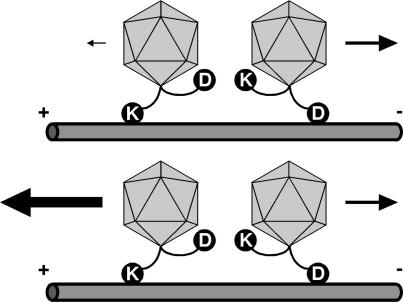Fig. 5.
Coordination of a bidirectional motor complex directs capsid transport. Shown is a model contrasting transport dynamics of herpesvirus capsids during entry and egress. Dynein (D) and a kinesin family (KIF; K) motor are illustrated bound to individual capsids simultaneously as part of a coordinated bidirectional motor complex. A direct interaction of capsids with motor complexes is shown for illustrative purposes only. The interaction of motors with cargo or each other could be direct or indirect by means of additional proteins. Net retrograde motion required for entry results when the contribution of the KIF motor in the complex is reduced (Upper). Alternatively, increasing the KIF contribution results in net anterograde motion required for egress (Lower). The contribution of the dynein motor does not change during entry and egress in this model.

